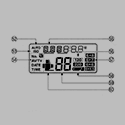|
What games do such a significant amount of writing to affect QLC cache? I would think most games get installed and after that they are read only, except for config changes and save states.
|
|
|
|

|
| # ? Apr 18, 2024 12:45 |
|
Saukkis posted:What games do such a significant amount of writing to affect QLC cache? I would think most games get installed and after that they are read only, except for config changes and save states. I think by definition a cache is going to have some writing because it's going to be moving stuff in/out depending on what needs to be cached at any given time.
|
|
|
|
It's strictly a write cache. Data gets stored in there very quickly and then written to the QLC cells at its actual, much slower rate. If you're not writing to it it's not getting used at all (besides whatever was last saved there).
|
|
|
|
ItBreathes posted:It's strictly a write cache. Data gets stored in there very quickly and then written to the QLC cells at its actual, much slower rate. If you're not writing to it it's not getting used at all (besides whatever was last saved there). This. If you keep your QLC drive not 100% full it won't matter. If you're the type to fill it up to the gills, read performance drops by as much as half for a lot of QLC drives. But, yeah, no game is going to be writing enough to bother a DRAM/SLC cache.
|
|
|
|
BIG HEADLINE posted:The "not too bad" factor of QLC drives lasts about as long as your first instance where the cache gets saturated and it gets you killed in a game because it turns into a slideshow. People still play games just fine from spinning hard drives ya goofus. The only time that the storage system turns a game into a slideshow is if you're forced into swap space from memory, and if that happens even the fastest nvme drive won't save you. QLC isn't some contagious slowdown disease, and the 660p and other QLC drives are pretty drat smart about how they conceal the downsides. Certainly smart enough to handle video games, which are a very easy and simple type of workload. If anyone is looking at Anandtech's "the destroyer" benchmark and thinking it has any relevance to gaming in the slightest you're waaaaay off base.
|
|
|
|
The 1TB 860 QVO will drop to HDD speeds of sub 80MB/sec when the write cache is full, but I agree that it probably isn't something that will ever affect gaming - unless you're continuously writing dozens/hundreds of GB to the drive in the background at the same time the game is also loading textures.
|
|
|
|
basically if you want to capture sick 4k60 you're probably already at the price point where you at least could afford a high capacity tlc drive
|
|
|
|
Xenomorph posted:The 1TB 860 QVO will drop to HDD speeds of sub 80MB/sec when the write cache is full, but I agree that it probably isn't something that will ever affect gaming - unless you're continuously writing dozens/hundreds of GB to the drive in the background at the same time the game is also loading textures. Might happen with Nvidia Shadowplay, I guess?
|
|
|
|
A 2 TB 660p has about 70 GB of SLC cache, so when used as a secondary game drive, you will only hit the limit while installing games.
|
|
|
|
Tamba posted:Might happen with Nvidia Shadowplay, I guess? Shadowplay works by keeping a rolling buffer of the last N minutes. So if N is a reasonable number you never run out of cache space -- when data gets deleted that free space can be re-used. Same with swap space if someone is using one of these as their main system drive. As long as your working data is small enough to fit in the write cache you generally won't be penalized by the QLC slowness. I'm also pretty sure the drives are fairly 'lazy' about moving data from the SLC cache to QLC, if only because the write endurance penalty for QLC writes is so awful. If every bit got moved to QLC asap they wouldn't have 200TB of spec endurance. So when the drive needs to move data into QLC I'd guess that it goes oldest first. The variable size of the SLC cache is a thing to keep in mind though, and the reason that we generally recommend the drives more for secondary storage ITT. The price advantage of a 660p gets nullified if you have to keep 20% free space all the time. Klyith fucked around with this message at 16:13 on Jan 29, 2020 |
|
|
|
Also remember that for a lot of QLC drives, such as the 660p, read performance is also impacted by the drive being >95% or so full, not just writes. So it's entirely possible to choke your game by simply having over-filled your drive. But yeah, I agree in general that QLC isn't some horrendous and terrible technology that has no place in your computer. Depending on sales and such, it can provide a substantially cheaper option for large storage than TCL.
|
|
|
|
Just driveby posting my regrets of faffing about geting new parts, I could have gotten a 1TB Corsair Force MP510 or ADATA XPG SX8200 Pro for around 130€. The Force MP510 has had a disgusting price jump up to 170€ with the SX8200 only going up to 150€ in comparison. Really kicking myself at the MP510, as far as I undestood it has amazing read/write longevity so I was figuring that I could just get that and not worry about my SSD for a good while since it would be just handling games/media. Now looking at doubling up with 1TB MX500, one NVME and one SATA at around 115€ each for storage on my new PC.
|
|
|
|
To reiterate: do not worry about write endurance on your >256GB SSD if you're a normal person doing normal person things. Even a drive with "only" 200TBW write endurance will easily last a normal user >10 years of daily heavy use. Write endurance is for enterprise loads and weirdos doing 100's of GB of database writes or whatever a day.
|
|
|
|
Lambert posted:A 2 TB 660p has about 70 GB of SLC cache, so when used as a secondary game drive, you will only hit the limit while installing games. The drive can clear around 175MB/s of qlc write speed when the cache is exhausted. So it should easily handle game installations from a gigabit connection even if your drive is full, without utilizing the cache at all.
|
|
|
|
Pretty much the only time you'd hit the cache limit doing standard consumer stuff is if you clone an old drive onto it. Even then, if it's a HDD you'll still probably be fine.
|
|
|
|
Steam allocates disk space before starting the download by writing an empty file. I know because one time I'd just deleted GTA5 from my nearly full 256 GB Samsung 830 to download a different big game and had to look at the allocation progress crawl along because TRIM hadn't had a chance to do its thing yet. So you might just hit the cache limit if you install a big enough game.
|
|
|
|
Geemer posted:Steam allocates disk space before starting the download by writing an empty file. I know because one time I'd just deleted GTA5 from my nearly full 256 GB Samsung 830 to download a different big game and had to look at the allocation progress crawl along because TRIM hadn't had a chance to do its thing yet. Allocating disk space does exactly what it says, it reserves disk space for files without writing them. The operation writes a comparatively trivial amount of data to the NTFS master file table, like "game.dat is 4 GB and takes up <clusters> on the disk". It doesn't write all zeros across 4GB or something.
|
|
|
|
Encrypted posted:Yeah those 10Gbps connections is really taxing on the system. According to some benchmarks, it drops down to about 60-70 MB/s - others have it in the 150 MB/s range when full. So it's very much possible to notice with Gigabit connections if 60-70 MB/s are true, but it doesn't really matter either way. Lambert fucked around with this message at 15:04 on Jan 31, 2020 |
|
|
|
Klyith posted:Allocating disk space does exactly what it says, it reserves disk space for files without writing them. The operation writes a comparatively trivial amount of data to the NTFS master file table, like "game.dat is 4 GB and takes up <clusters> on the disk". It doesn't write all zeros across 4GB or something. That's what I always figured and expect, but it sure isn't the behavior I got in that situation. I even opened resource monitor to check and saw Steam was writing data the whole time. Maybe the 830's controller gets weird about space it hasn't trimmed yet being allocated?
|
|
|
|
Geemer posted:That's what I always figured and expect, but it sure isn't the behavior I got in that situation. I even opened resource monitor to check and saw Steam was writing data the whole time. The drive itself is agnostic to the file system, so the NTFS MFT allocating space would not be something the controller is yet aware of. As far as the ssd is concerned the MFT is just data like anything else. OTOH I don't know what Steam is actually doing during this step; if it is pushing data around and not just reserving disk space for files then it must be doing something. #1, they could be allocating a file the old-fashioned way & writing zeroes to the whole thing. This would be kinda dumb IMHO, but is more universal since FAT32 and ancient versions of NTFS can't do sparse files. #2, they could be trying to create contiguous space for files, which would be very useful for HDDs and still has some* validity for SSDs. *SSDs don't care about fragmentation, but the file system still kinda does. If a file is split into 10k pieces instead of 1, all that metadata for where the pieces are has to be recorded in the MFT. Super-fragmented files can cause slowdown even on SSDs just from having to deal with processing all those lookups. This is NOT a problem that ordinary users need to worry about.
|
|
|
|
Are these Samsung mSATA OEM SSDs any good? Seems like they are mostly Dell OEM pulls. PM871/PM851 models. I have a project where I need an mSATA.
|
|
|
|
Shaocaholica posted:Are these Samsung mSATA OEM SSDs any good? Seems like they are mostly Dell OEM pulls. PM871/PM851 models. I have a project where I need an mSATA. I know the PM851's had some kind of slowdown but so make sure it's patchable if you get one of those
|
|
|
|
I wonder if they’re supported by magician for FW updates. Well I’ll find out soon.
|
|
|
|
They shouldn't be - Magician is only for consumer drives. Samsung makes standalone firmware updaters available for OEM drives like the 851
|
|
|
|
Encrypted posted:Yeah those 10Gbps connections is really taxing on the system. Lambert posted:According to some benchmarks, it drops down to about 60-70 MB/s - others have it in the 150 MB/s range when full. So it's very much possible to notice with Gigabit connections if 60-70 MB/s are true, but it doesn't really matter either way. This. I recall ~80 MB/s write speed to the 660p's raw QLC flash. Shaocaholica posted:Are these Samsung mSATA OEM SSDs any good? Seems like they are mostly Dell OEM pulls. PM871/PM851 models. I have a project where I need an mSATA. They should be just fine; IIRC they're slightly less capable versions of the analogous consumer drives. I've used them in various form factors in mobile devices, and they're as capable as any recent SATA SSD. In short, if the price is right go for it.
|
|
|
|
I bought my first SSD, a Samsung 960 EVO 500GB M.2 in September of 2017. It's been running great since then, seeing light to moderate use, but I've heard this things have a shorter lifespan and I've heard about 2 years. It's still running just fine as far as I can tell, but is there anything I should be monitoring or watching for that would indicate when it's about to die? I'd like to keep the downtime to a minimum.
|
|
|
|
That's nonsense, those have TLC NAND that will last for many years. If you want to see the health of your SSD, download Samsung Magician.
|
|
|
|
If you are on a Mac you can use HWSensors https://sourceforge.net/projects/hwsensors/ Works on both real and Hacks. Hacks being Hacks might be missing or misreporting some other stats, this does not represent an malfunction of the machine itself. It's HWMonitor but much better UI overall but less verbose. I have ran a 840 and 850 EVO 1 TB (TLC) for long enough I think the 840 is out of warranty so 5+ years. Both read 96% life remaining. In every stress test done which does things no user would do rated write lifetime was found to be very conservative. The Samsung were like 3+ times or stopped test because it didn't fail within the tests runtime of a month iirc. "You die before the SSD dies". Even the lower brand ones were getting more than the stated number. It's why the Samsung continues to have a premium, it's top dog. I expect the box numbers to be more precise these days. Another machine runs an Intel SSD  almost as old as the 840. No glitch or failures. A younger Sammy 740 in a laptop is the same. almost as old as the 840. No glitch or failures. A younger Sammy 740 in a laptop is the same.SSDs are increasingly commodities much like spinning rust of old which still have their uses for now. Not quite there yet as there are cut price SSD no one should use and there are significant internal differences that can impact performance. There are increasingly good mid range SSDs to buy if you don't want or need the Sammy premium. The only hard NO is using an SSD for cold archiving. 6 Months can be enough to start losing data.
|
|
|
|
counterfeitsaint posted:I've heard this things have a shorter lifespan and I've heard about 2 years. It's still running just fine as far as I can tell, but is there anything I should be monitoring or watching for that would indicate when it's about to die? I'd like to keep the downtime to a minimum. That might vaguely be true if you were using it in a enterprise datacenter environment. As a home user, you are absolutely nowhere near hitting any sort of write/wear limit. The 960 Evo 500 is specced for 200TBW. That's about 50 GB written every day for 10 years straight. And as was pointed out above, when they were actually tested they lasted far longer than the spec sheet required. You're fine.
|
|
|
|
Thanks guy, glad to hear it.
|
|
|
|
Of course you should still be taking backups of any data you would rather not lose. While modern SSDs rarely die from flash cell failure, there's also the risk of them suddenly dying from controller failure. It's rare but it happens.
|
|
|
|
|
oohhboy posted:If you are on a Mac you can use HWSensors The last thing you said is probably wrong. I turned on one of the original OCZ SSDs in an old machine and it booted right up after being off for like 7 years.
|
|
|
|
Got something better than an anecdote?
|
|
|
|
I’m looking for a good 2TB NVMe drive and a good 2TB 2 inch drive. Preferably less than 3 hundo each. Any suggestions?
|
|
|
|
Ugly In The Morning posted:I’m looking for a good 2TB NVMe drive and a good 2TB 2 inch drive. Preferably less than 3 hundo each. Any suggestions?
|
|
|
|
redeyes posted:The last thing you said is probably wrong. I turned on one of the original OCZ SSDs in an old machine and it booted right up after being off for like 7 years. An ancient drive like that is actually better at data retention than a modern one. It's SLC or MLC, not TLC. And the NAND tech used back then was different I think, more like the flash in a usb drive than what's in drives now. But more importantly, booting the OS is not a test of data retention. When people say SSDs have data retention problems, they're not implying that the whole drive blanks itself. The things you're looking for are 1- or 2-bit errors scattered randomly across the whole drive. That might hit critical code parts of the OS, or it might just be hitting all the other junk. So unless you have checksums from 7 years ago you haven't tested jack poo poo. Ugly In The Morning posted:I’m looking for a good 2TB NVMe drive and a good 2TB 2 inch drive. Preferably less than 3 hundo each. Any suggestions? 2TB 2.5" sata- Crucial MX500 is currently on sale for $200 at newegg if you're ready to buy now, otherwise the cheaper of that and a WD Blue. 2TB NVMe - HP EX950 or Adata XPG 8100 pro Klyith fucked around with this message at 22:39 on Feb 7, 2020 |
|
|
|
Encrypted posted:Yeah those 10Gbps connections is really taxing on the system. My 1TB 660p hit a very consistent wall of 100MB/s once the write cache was exhausted while I was copying my steam library from the 750 evo.
|
|
|
redeyes posted:The last thing you said is probably wrong. I turned on one of the original OCZ SSDs in an old machine and it booted right up after being off for like 7 years. I tried reusing an old Intel SSD that had sat unused for 5+ years and it would consistently hang or fail on operations and eventually lock the host system.
|
|
|
|
|
Ugly In The Morning posted:I’m looking for a good 2TB NVMe drive and a good 2TB 2 inch drive. Preferably less than 3 hundo each. Any suggestions? Assuming the latter means "2 TB 2.5" SSD" (because this is clearly not the boot drive and you might very well be interested in a 2 TB FireCuda for $60 just for games) how about an 860 QVO for $160?
|
|
|
|

|
| # ? Apr 18, 2024 12:45 |
|
Klyith posted:An ancient drive like that is actually better at data retention than a modern one. It's SLC or MLC, not TLC. And the NAND tech used back then was different I think, more like the flash in a usb drive than what's in drives now. It's probably MLC, and could easily have worse retention. The era before 3D NAND saw planar MLC pushed to its practical limits. By the end of planar, the charge traps were so small they could hold only a handful of electrons, and insulation around them was quite thin. Leaky charge storage cells with little capacity isn't a great recipe for retention. 3D changed everything. The density advantage of going vertical meant it was okay to effectively go back a couple process nodes in feature size, so they were able to put better insulation around the charge traps and increase their size. They've probably eaten back into that margin a bit by now since 3D is now a mature tech; for contrast I remember reading that the initial generation of Samsung 3D NAND was deliberately very conservative on feature sizes out of a desire to de-risk it. Not sure what you mean wrt usb drives, they use basically the same nand as anything else, it's just low grade. Whatever is cheapest per byte. So, these days, QLC. It's definitely not better at retention (see: low grade, QLC). quote:But more importantly, booting the OS is not a test of data retention. When people say SSDs have data retention problems, they're not implying that the whole drive blanks itself. The things you're looking for are 1- or 2-bit errors scattered randomly across the whole drive. That might hit critical code parts of the OS, or it might just be hitting all the other junk. The SSD itself has checksums from 7 years ago. Every block of user data on it is protected by ECC codes which let the SSD fix those 1- or 2-bit (or more) errors. If its firmware is any good it will report any failures to correct data in SMART attribute 187 (uncorrectable error count). If it's a major name brand like Samsung or Intel (anyone you feel confident about not fudging their implementation of 187 and error correction in general), I would feel pretty good about data integrity on a previously shelved drive if I was able to read out all the data without causing 187 to count up. (You can get unlucky with uncaught errors, but that's true of any checksum no matter what layer of the stack it's implemented in, and the codes used inside SSDs are generally pretty strong.) All that said, I'm in full agreement with not using SSDs as offline backup. This is increasingly true the more wear you put on a drive. Like, I wouldn't be surprised if a brand new unused Samsung 850 Pro (which uses that very conservatively engineered first generation 3D NAND) successfully retained data for 10 years or more. But as write erase cycles pile up, you're making those charge traps leakier and leakier, and hence power-off bit fade worse and worse. Power-on still has fade, but the drives have background scrubber threads which find fading blocks and rewrite them before they degrade too far and become an uncorrectable error.
|
|
|































